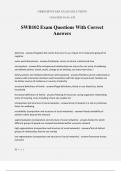©BRIGHTSTARS EXAM SOLUTIONS
11/16/2024 10:16 AM
SWB102 Exam Questions With Correct
Answers
Adversity - answer✔negative life events that occur to us; impact isn't necessarily going to be
negative
outer world dimensions - answer✔relational, social, structural, cultural and time
microsystem - answer✔the interpersonal relationships we rely on for our sense of wellbeing
and identity (home, school, work), change as we develop, can have more than 1
family systems and relational dimension (microsystem) - answer✔families can be understood as
systems with interactive members and transactions with the larger environment, families can
be bother sources of resilience or sources of adverity
structural definitions of family - answer✔legal definitions, blood or non-blood ties, family
household
functional definitions of family - answer✔sharing of resources, caring supportive relationship,
sense of meaning, more including of sam-sex couples etc
composition and structure of social networks - answer✔size of network is a risk or protective
factor for wellbeing
reachability (composition and structure of social networks) - answer✔ready availability of
another within beyond the network
segmentalisation (composition and structure of social networks) - answer✔extent to which
different groups of people are compartmentalised within a persons network
high segmentation (composition and structure of social networks) - answer✔lots of distinct
groups of relationships that do not overlap
low segmentation (composition and structure of social networks) - answer✔everyone knows
everyone
1|Page
, ©BRIGHTSTARS EXAM SOLUTIONS
11/16/2024 10:16 AM
factors impacting capacity to connect to community - answer✔age, living by yourself,
retirement, health/mental health, social class, financial status
threats to community/connection - answer✔being forced to move, work/life balance, urban
poverty, imprisonment
structural (ecosystem) - answer✔key systems that influence our individual, interpersonal and
social contexts, decisions made in these systems influence out daily life (insitutional systems,
resources etc)
key structural influences - answer✔capitalism, neoliberalism, globalisation, welfare state
capitalism - answer✔provides fundamental and inevitable class division between owners and
non-owners of captial
neoliberalism - answer✔emphasises the importance of individual responsibility rather than
state provision and maintained that a government role was to support the market
globalisation - answer✔refers to large scale changes that bring together previously separate
societies into a global network
welfare state - answer✔how governments facilitate or restrict access to resources and
opportunities that assist people to live independent and meaningful lives (thru social and
economic policies)
poverty - answer✔has multiple consequences such as poorer health, housing, educational and
safety outcomes
culture - answer✔Beliefs, customs, and traditions of a specific group of people, shapes our
beliefs about what is right or wrong, acceptable or unacceptable, social or antisocial. govern
our way of life
Trust vs. Mistrust (Erikson) - answer✔(0-1), trust is learned, mistrust occurs when the child
sense they may be in danger and shies away from care giver
Autonomy vs. Shame and Doubt - answer✔1-3, "I can do it myself", working on self control,
shame is when there's a feeling of being estranged from caregivers, or not being able to
complete tasks, child feels like a failure
Initiative vs. Guilt - answer✔3-6, discovering the type of person they will be through play, learn
to move more, language is perfected and locomotion and language expand,
2|Page




